CHEVROLET KODIAK 2009 Manual Online
Manufacturer: CHEVROLET, Model Year: 2009, Model line: KODIAK, Model: CHEVROLET KODIAK 2009Pages: 376, PDF Size: 5.39 MB
Page 81 of 376
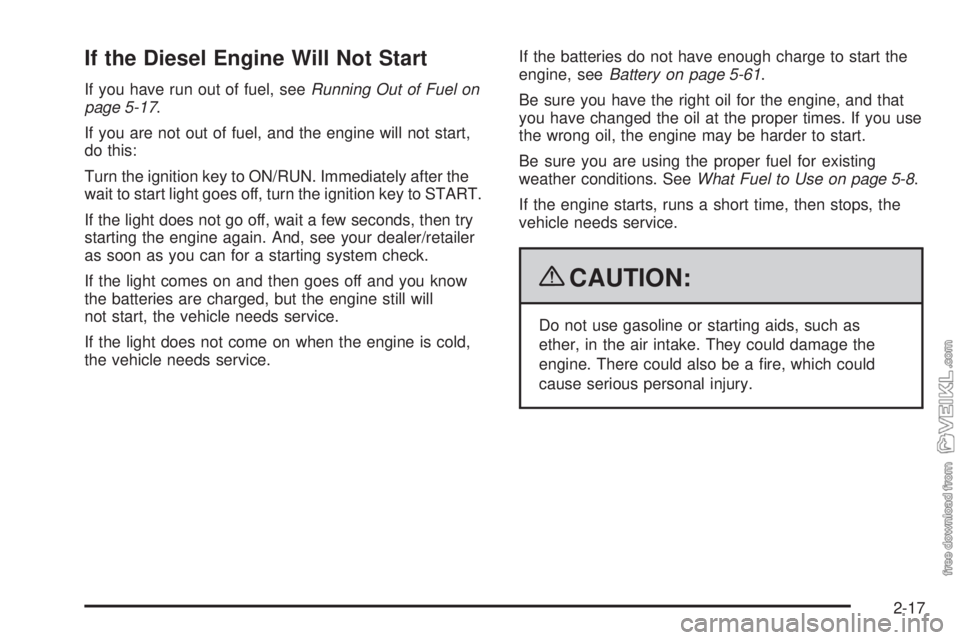
If the Diesel Engine Will Not Start
If you have run out of fuel, seeRunning Out of Fuel on
page 5-17.
If you are not out of fuel, and the engine will not start,
do this:
Turn the ignition key to ON/RUN. Immediately after the
wait to start light goes off, turn the ignition key to START.
If the light does not go off, wait a few seconds, then try
starting the engine again. And, see your dealer/retailer
as soon as you can for a starting system check.
If the light comes on and then goes off and you know
the batteries are charged, but the engine still will
not start, the vehicle needs service.
If the light does not come on when the engine is cold,
the vehicle needs service.If the batteries do not have enough charge to start the
engine, seeBattery on page 5-61.
Be sure you have the right oil for the engine, and that
you have changed the oil at the proper times. If you use
the wrong oil, the engine may be harder to start.
Be sure you are using the proper fuel for existing
weather conditions. SeeWhat Fuel to Use on page 5-8.
If the engine starts, runs a short time, then stops, the
vehicle needs service.
{CAUTION:
Do not use gasoline or starting aids, such as
ether, in the air intake. They could damage the
engine. There could also be a fire, which could
cause serious personal injury.
2-17
Page 82 of 376
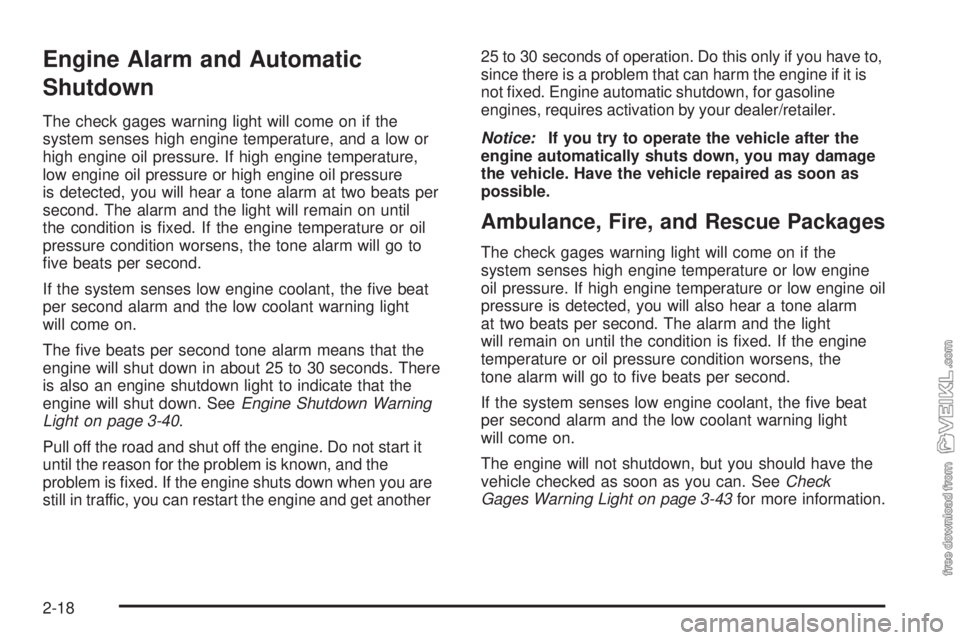
Engine Alarm and Automatic
Shutdown
The check gages warning light will come on if the
system senses high engine temperature, and a low or
high engine oil pressure. If high engine temperature,
low engine oil pressure or high engine oil pressure
is detected, you will hear a tone alarm at two beats per
second. The alarm and the light will remain on until
the condition is fixed. If the engine temperature or oil
pressure condition worsens, the tone alarm will go to
five beats per second.
If the system senses low engine coolant, the five beat
per second alarm and the low coolant warning light
will come on.
The five beats per second tone alarm means that the
engine will shut down in about 25 to 30 seconds. There
is also an engine shutdown light to indicate that the
engine will shut down. SeeEngine Shutdown Warning
Light on page 3-40.
Pull off the road and shut off the engine. Do not start it
until the reason for the problem is known, and the
problem is fixed. If the engine shuts down when you are
still in traffic, you can restart the engine and get another25 to 30 seconds of operation. Do this only if you have to,
since there is a problem that can harm the engine if it is
not fixed. Engine automatic shutdown, for gasoline
engines, requires activation by your dealer/retailer.
Notice:If you try to operate the vehicle after the
engine automatically shuts down, you may damage
the vehicle. Have the vehicle repaired as soon as
possible.
Ambulance, Fire, and Rescue Packages
The check gages warning light will come on if the
system senses high engine temperature or low engine
oil pressure. If high engine temperature or low engine oil
pressure is detected, you will also hear a tone alarm
at two beats per second. The alarm and the light
will remain on until the condition is fixed. If the engine
temperature or oil pressure condition worsens, the
tone alarm will go to five beats per second.
If the system senses low engine coolant, the five beat
per second alarm and the low coolant warning light
will come on.
The engine will not shutdown, but you should have the
vehicle checked as soon as you can. SeeCheck
Gages Warning Light on page 3-43for more information.
2-18
Page 83 of 376
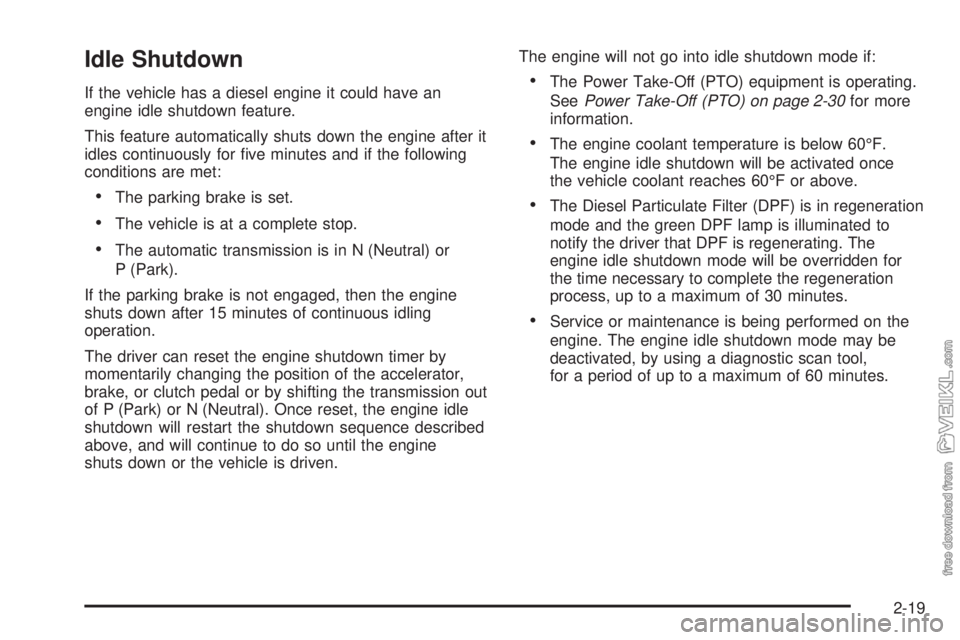
Idle Shutdown
If the vehicle has a diesel engine it could have an
engine idle shutdown feature.
This feature automatically shuts down the engine after it
idles continuously for five minutes and if the following
conditions are met:
•The parking brake is set.
•The vehicle is at a complete stop.
•The automatic transmission is in N (Neutral) or
P (Park).
If the parking brake is not engaged, then the engine
shuts down after 15 minutes of continuous idling
operation.
The driver can reset the engine shutdown timer by
momentarily changing the position of the accelerator,
brake, or clutch pedal or by shifting the transmission out
of P (Park) or N (Neutral). Once reset, the engine idle
shutdown will restart the shutdown sequence described
above, and will continue to do so until the engine
shuts down or the vehicle is driven.The engine will not go into idle shutdown mode if:
•The Power Take-Off (PTO) equipment is operating.
SeePower Take-Off (PTO) on page 2-30for more
information.
•The engine coolant temperature is below 60°F.
The engine idle shutdown will be activated once
the vehicle coolant reaches 60°F or above.
•The Diesel Particulate Filter (DPF) is in regeneration
mode and the green DPF lamp is illuminated to
notify the driver that DPF is regenerating. The
engine idle shutdown mode will be overridden for
the time necessary to complete the regeneration
process, up to a maximum of 30 minutes.
•Service or maintenance is being performed on the
engine. The engine idle shutdown mode may be
deactivated, by using a diagnostic scan tool,
for a period of up to a maximum of 60 minutes.
2-19
Page 84 of 376
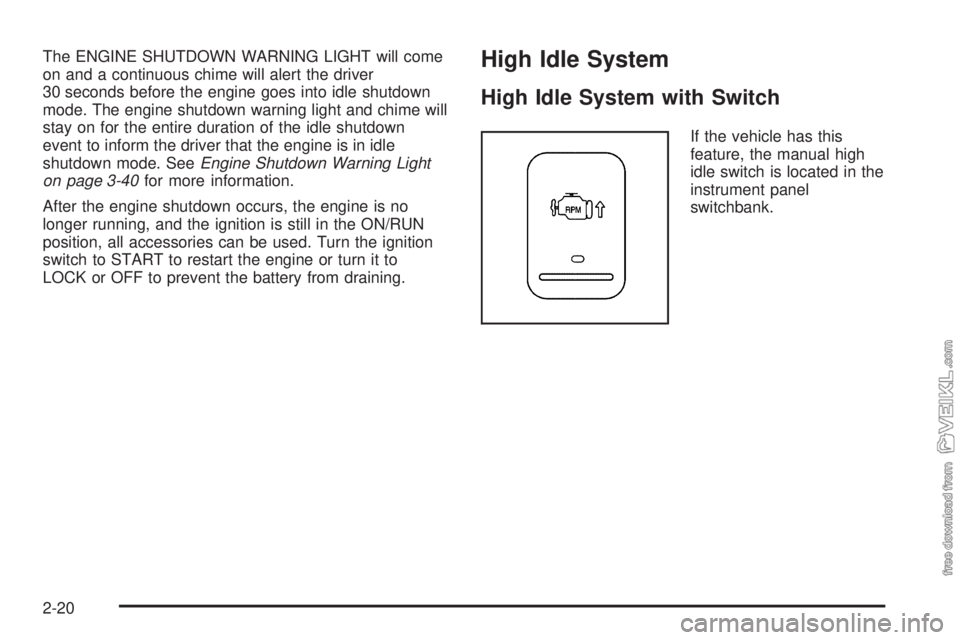
The ENGINE SHUTDOWN WARNING LIGHT will come
on and a continuous chime will alert the driver
30 seconds before the engine goes into idle shutdown
mode. The engine shutdown warning light and chime will
stay on for the entire duration of the idle shutdown
event to inform the driver that the engine is in idle
shutdown mode. SeeEngine Shutdown Warning Light
on page 3-40for more information.
After the engine shutdown occurs, the engine is no
longer running, and the ignition is still in the ON/RUN
position, all accessories can be used. Turn the ignition
switch to START to restart the engine or turn it to
LOCK or OFF to prevent the battery from draining.High Idle System
High Idle System with Switch
If the vehicle has this
feature, the manual high
idle switch is located in the
instrument panel
switchbank.
2-20
Page 85 of 376
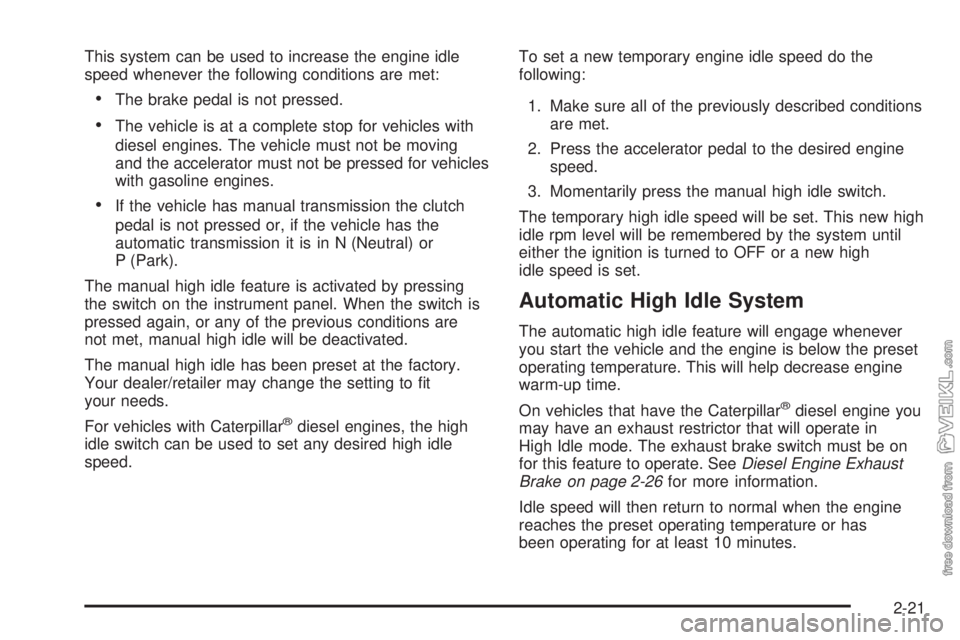
This system can be used to increase the engine idle
speed whenever the following conditions are met:
•The brake pedal is not pressed.
•The vehicle is at a complete stop for vehicles with
diesel engines. The vehicle must not be moving
and the accelerator must not be pressed for vehicles
with gasoline engines.
•If the vehicle has manual transmission the clutch
pedal is not pressed or, if the vehicle has the
automatic transmission it is in N (Neutral) or
P (Park).
The manual high idle feature is activated by pressing
the switch on the instrument panel. When the switch is
pressed again, or any of the previous conditions are
not met, manual high idle will be deactivated.
The manual high idle has been preset at the factory.
Your dealer/retailer may change the setting to fit
your needs.
For vehicles with Caterpillar
®diesel engines, the high
idle switch can be used to set any desired high idle
speed.To set a new temporary engine idle speed do the
following:
1. Make sure all of the previously described conditions
are met.
2. Press the accelerator pedal to the desired engine
speed.
3. Momentarily press the manual high idle switch.
The temporary high idle speed will be set. This new high
idle rpm level will be remembered by the system until
either the ignition is turned to OFF or a new high
idle speed is set.
Automatic High Idle System
The automatic high idle feature will engage whenever
you start the vehicle and the engine is below the preset
operating temperature. This will help decrease engine
warm-up time.
On vehicles that have the Caterpillar
®diesel engine you
may have an exhaust restrictor that will operate in
High Idle mode. The exhaust brake switch must be on
for this feature to operate. SeeDiesel Engine Exhaust
Brake on page 2-26for more information.
Idle speed will then return to normal when the engine
reaches the preset operating temperature or has
been operating for at least 10 minutes.
2-21
Page 86 of 376
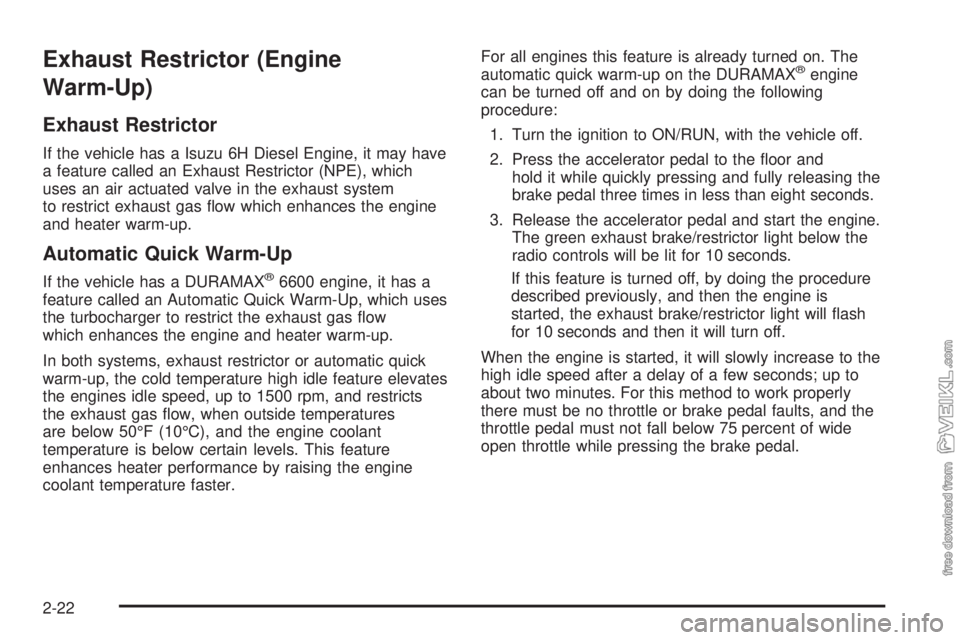
Exhaust Restrictor (Engine
Warm-Up)
Exhaust Restrictor
If the vehicle has a Isuzu 6H Diesel Engine, it may have
a feature called an Exhaust Restrictor (NPE), which
uses an air actuated valve in the exhaust system
to restrict exhaust gas flow which enhances the engine
and heater warm-up.
Automatic Quick Warm-Up
If the vehicle has a DURAMAX®6600 engine, it has a
feature called an Automatic Quick Warm-Up, which uses
the turbocharger to restrict the exhaust gas flow
which enhances the engine and heater warm-up.
In both systems, exhaust restrictor or automatic quick
warm-up, the cold temperature high idle feature elevates
the engines idle speed, up to 1500 rpm, and restricts
the exhaust gas flow, when outside temperatures
are below 50°F (10°C), and the engine coolant
temperature is below certain levels. This feature
enhances heater performance by raising the engine
coolant temperature faster.For all engines this feature is already turned on. The
automatic quick warm-up on the DURAMAX
®engine
can be turned off and on by doing the following
procedure:
1. Turn the ignition to ON/RUN, with the vehicle off.
2. Press the accelerator pedal to the floor and
hold it while quickly pressing and fully releasing the
brake pedal three times in less than eight seconds.
3. Release the accelerator pedal and start the engine.
The green exhaust brake/restrictor light below the
radio controls will be lit for 10 seconds.
If this feature is turned off, by doing the procedure
described previously, and then the engine is
started, the exhaust brake/restrictor light will flash
for 10 seconds and then it will turn off.
When the engine is started, it will slowly increase to the
high idle speed after a delay of a few seconds; up to
about two minutes. For this method to work properly
there must be no throttle or brake pedal faults, and the
throttle pedal must not fall below 75 percent of wide
open throttle while pressing the brake pedal.
2-22
Page 87 of 376
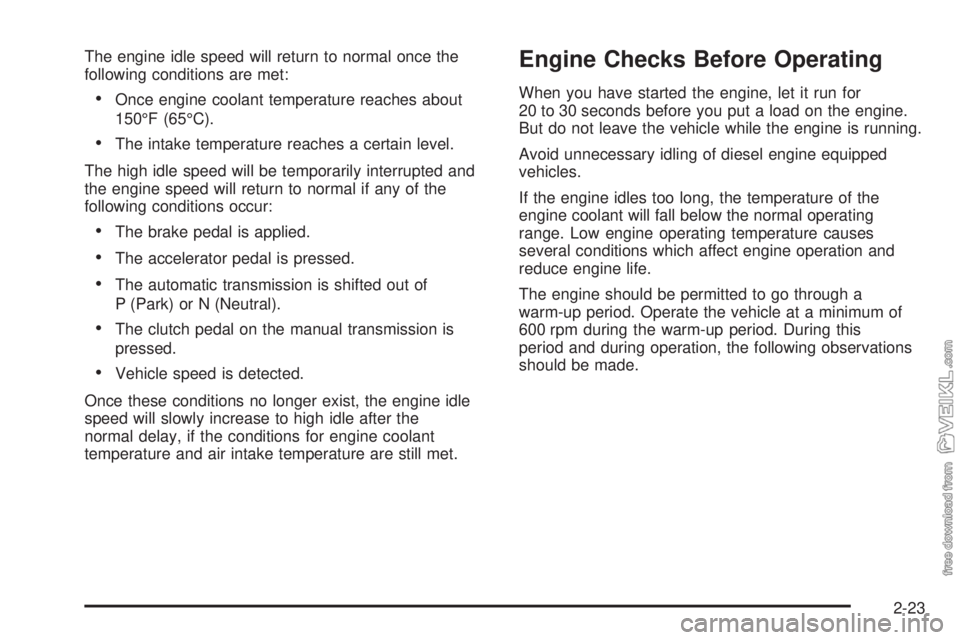
The engine idle speed will return to normal once the
following conditions are met:
•Once engine coolant temperature reaches about
150°F (65°C).
•The intake temperature reaches a certain level.
The high idle speed will be temporarily interrupted and
the engine speed will return to normal if any of the
following conditions occur:
•The brake pedal is applied.
•The accelerator pedal is pressed.
•The automatic transmission is shifted out of
P (Park) or N (Neutral).
•The clutch pedal on the manual transmission is
pressed.
•Vehicle speed is detected.
Once these conditions no longer exist, the engine idle
speed will slowly increase to high idle after the
normal delay, if the conditions for engine coolant
temperature and air intake temperature are still met.
Engine Checks Before Operating
When you have started the engine, let it run for
20 to 30 seconds before you put a load on the engine.
But do not leave the vehicle while the engine is running.
Avoid unnecessary idling of diesel engine equipped
vehicles.
If the engine idles too long, the temperature of the
engine coolant will fall below the normal operating
range. Low engine operating temperature causes
several conditions which affect engine operation and
reduce engine life.
The engine should be permitted to go through a
warm-up period. Operate the vehicle at a minimum of
600 rpm during the warm-up period. During this
period and during operation, the following observations
should be made.
2-23
Page 88 of 376
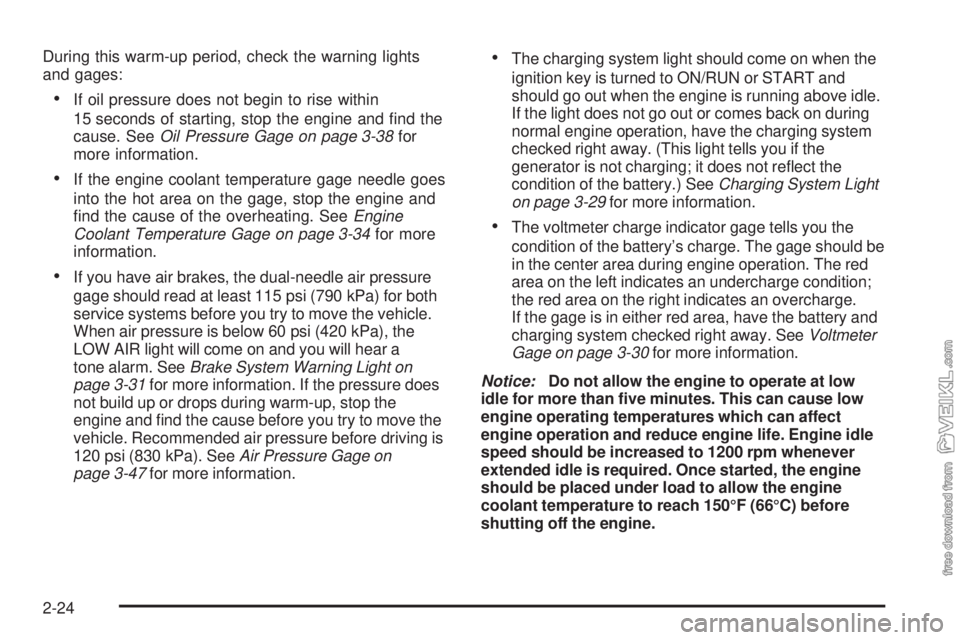
During this warm-up period, check the warning lights
and gages:
•If oil pressure does not begin to rise within
15 seconds of starting, stop the engine and find the
cause. SeeOil Pressure Gage on page 3-38for
more information.
•If the engine coolant temperature gage needle goes
into the hot area on the gage, stop the engine and
find the cause of the overheating. SeeEngine
Coolant Temperature Gage on page 3-34for more
information.
•If you have air brakes, the dual-needle air pressure
gage should read at least 115 psi (790 kPa) for both
service systems before you try to move the vehicle.
When air pressure is below 60 psi (420 kPa), the
LOW AIR light will come on and you will hear a
tone alarm. SeeBrake System Warning Light on
page 3-31for more information. If the pressure does
not build up or drops during warm-up, stop the
engine and find the cause before you try to move the
vehicle. Recommended air pressure before driving is
120 psi (830 kPa). SeeAir Pressure Gage on
page 3-47for more information.
•The charging system light should come on when the
ignition key is turned to ON/RUN or START and
should go out when the engine is running above idle.
If the light does not go out or comes back on during
normal engine operation, have the charging system
checked right away. (This light tells you if the
generator is not charging; it does not reflect the
condition of the battery.) SeeCharging System Light
on page 3-29for more information.
•The voltmeter charge indicator gage tells you the
condition of the battery’s charge. The gage should be
in the center area during engine operation. The red
area on the left indicates an undercharge condition;
the red area on the right indicates an overcharge.
If the gage is in either red area, have the battery and
charging system checked right away. SeeVoltmeter
Gage on page 3-30for more information.
Notice:Do not allow the engine to operate at low
idle for more than five minutes. This can cause low
engine operating temperatures which can affect
engine operation and reduce engine life. Engine idle
speed should be increased to 1200 rpm whenever
extended idle is required. Once started, the engine
should be placed under load to allow the engine
coolant temperature to reach 150°F (66°C) before
shutting off the engine.
2-24
Page 89 of 376
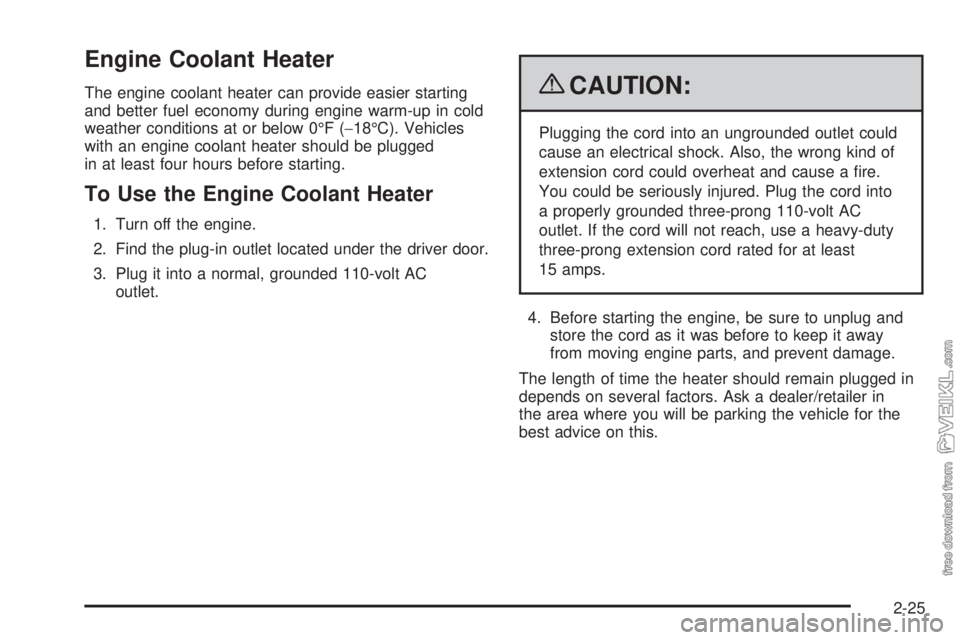
Engine Coolant Heater
The engine coolant heater can provide easier starting
and better fuel economy during engine warm-up in cold
weather conditions at or below 0°F (−18°C). Vehicles
with an engine coolant heater should be plugged
in at least four hours before starting.
To Use the Engine Coolant Heater
1. Turn off the engine.
2. Find the plug-in outlet located under the driver door.
3. Plug it into a normal, grounded 110-volt AC
outlet.
{CAUTION:
Plugging the cord into an ungrounded outlet could
cause an electrical shock. Also, the wrong kind of
extension cord could overheat and cause a fire.
You could be seriously injured. Plug the cord into
a properly grounded three-prong 110-volt AC
outlet. If the cord will not reach, use a heavy-duty
three-prong extension cord rated for at least
15 amps.
4. Before starting the engine, be sure to unplug and
store the cord as it was before to keep it away
from moving engine parts, and prevent damage.
The length of time the heater should remain plugged in
depends on several factors. Ask a dealer/retailer in
the area where you will be parking the vehicle for the
best advice on this.
2-25
Page 90 of 376

Diesel Engine Exhaust Brake
If the vehicle has a Isuzu 6H Diesel Engine, it may have
an exhaust brake, which is located in the exhaust
system.
If the vehicle has a 6.6L DURAMAX
®6600 or
Caterpillar®Diesel Engine, it may have an exhaust
brake, which is controlled through the turbocharger.
The exhaust brake for both engines operates the same.
The exhaust brake switch
is located in the instrument
panel switchbank.
Push the bottom of the switch to turn the exhaust brake
on. When you push the top of the switch, the exhaust
brake will turn off.
There is an indicator light on the instrument panel
similar to the symbol on the switch, that comes on when
the exhaust brake is active. SeeExhaust Brake
Indicator Light on page 3-41for more information.While using the exhaust brake, the proper gear range
selection is important. The exhaust brake is most
effective if the gear range selected is the lowest possible
range that does not allow the engine rpm to go more
than 200 rpm above rated (full load) rpm. If you have
a Caterpillar
®Diesel Engine, do not exceed 2900 rpm.
If you have an Isuzu 6H Diesel engine, do not
exceed 2550 rpm. If the vehicle has a DURAMAX
®
6600 Diesel Engine, do not exceed 3600 rpm.
If the vehicle has an Allison
®1000/2200/2300/2350/2500/
2550 series automatic transmission and this button is
pressed, the transmission downshifts to a factory default
setting of third gear. To change the default setting, or for
more information on factory default settings, contact your
dealer/retailer for assistance.
The accelerator and clutch pedals must be released in
order for the exhaust brake to engage. The exhaust
brake will automatically shut off when the antilock brake
system is active.
If the vehicle has a Caterpillar
®Diesel Engine or a
DURAMAX®6600 Diesel Engine, the exhaust brake will
become active in cruise control when you exceed the
set speed by 3 to 5 mph.
2-26